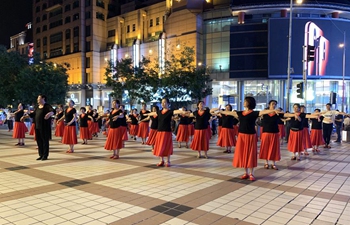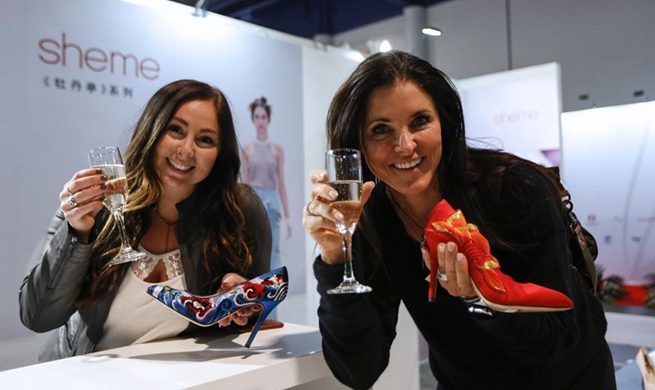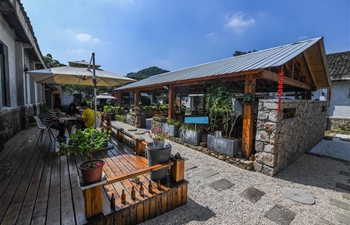BEIJING, Aug. 13 (Xinhua) -- The National Museum of China on Tuesday received a donation of 195 pieces of ancient porcelain from the wreck of the Tek Sing Cargo, an important record of the prosperity of China's Maritime Silk Road.
In 1822, the Tek Sing Cargo, loaded with silk and porcelain from China, sank in the waters off Indonesia. The sunken ship was salvaged by a commercial team in 1999, and the artifacts were then auctioned off.
Zheng Changlai, chair of Waterside Culture Group, a private Chinese firm which donated the relics to the museum, said that the shipwreck's blue-white porcelain wares were all made at the Dehua kilns in southeast China's Fujian Province in the Qing Dynasty (1644-1912). In 2018, the company purchased more than 100,000 of the relics from a British company.
Zheng said he hopes the donation to the national museum can attract more people to participate in the protection, inheritance and innovation of Chinese ceramic culture.
Geng Dongsheng, director of the Ceramics Institute of the Academy of the National Museum of China, said the shipwreck treasures with a clear chronology and sinking site are of great significance and value to the study of China's maritime trade in the 19th century and the route of the Maritime Silk Road as well as the porcelain making history in Dehua.
The Sintering Techniques of Dehua Porcelain has been inscribed on the list of China's National Intangible Cultural Heritage.
Archaeological findings show that with the rise of Quanzhou Port in Fujian as the largest port in the East, during the Song Dynasty (960-1297) and Yuan Dynasty (1279-1368), Dehua ceramics became bulk commodities on the ancient Maritime Silk Road.
RISE AND FALL
The small county has witnessed the rise and fall of the ceramic industry.
Chen Mingliang, China Arts and Crafts Master and a national inheritor of the Dehua ceramics technique, said in the Ming Dynasty (1368-1644), Dehua ceramic technique reached a peak with white porcelain produced as white as cream.
"That was why the French named Dehua-made ivory white porcelain 'Blanc de Chine' 300 years ago, which is still used today," said Chen. Wooed by European nobles, Dehua white porcelain also sparked the production of porcelain in Europe.
"Then in the Qing Dynasty, because of the huge overseas demand for Chinese porcelain utensils, the fine art production of Blanc de Chine porcelain gradually waned as craftsmen turned to mass produce blue and white porcelain utensils for export," said Chen.
Tek Sing shipwreck ceramics are evidence of the mass exports of Dehua porcelain wares, he said.
REVIVAL
It was not until the 1960s that Dehua ceramic craftsmen researched how to resume the traditional sintering method of Blanc de Chine porcelain, which had been interrupted for decades.
Chen has stuck to Blanc de Chine art porcelain making in Dehua. He said it is necessary to combine traditional techniques to create works suitable for contemporary aesthetics so that the porcelain can revive its past glory.
The only remaining ancient kiln in Dehua is the Yueji Kiln, which has been burning continuously for more than 400 years.
It still churns off four batches of pottery wares a year. The production attracts ceramic makers and visitors from all over the world.
Lin Zeyang, a 27-year-old local in Dehua, rents two small houses near the kiln as her ceramics workshop. She said now people use electric kilns to make ceramics, which are convenient and easy to operate. But in the ancient wood-burning kilns, each ceramic takes on a unique shape because of the uneven heating.
"This imperfection creates an individuality that cannot be replicated by today's modern machinery, a quality which has been gaining in popularity among consumers at home and abroad in recent years," she said.
She said creators can rent space in the Yueji Kiln to create their own works. Last year, her porcelain production from the kiln was unable to keep up with incoming orders.
Dehua is still China's largest production and export base of ceramic handicrafts.
By the end of 2018, there were more than 3,000 ceramic enterprises in Dehua, employing more than 100,000 people, with a yearly output value of 32.85 billion yuan (4.65 billion U.S. dollars), and the products were sold to 190 countries and regions.
The popular export ceramics have changed from porcelain figures and utensils in ancient times to Western craft porcelain.
From porcelain souvenirs sold in Universal Studios and Disneyland theme parks around the world and hot-selling ceramic cups in Starbucks to small porcelain models found in European and American gardens or gift porcelain for Christmas and Easter, most of them come from this one small county in southern China.
Zheng Pengfei, manager of Shunmei Ceramic Cultural Enterprise, one of the largest ceramic exporters in Dehua, said the company has earned international bargaining power with its exports. Its household porcelain wares can now be found on the shelves of Wal-Mart and other major international retailers.
He said Dehua porcelain needs to continue to impress the world not only with its considerable production but also its innovation and technique.

















